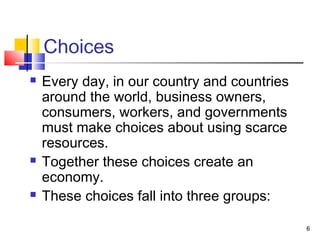Typesofeconomicsystems 120210161905-phpapp02 (1)
- 1. Types of Economic Systems
- 2. What is an Economy? ? An economy, or economic system, is the way a nation makes economic choices about how the nation will use its resources to produce and distribute goods and services. 2
- 3. Resources ? Also called factors of production, are all the things used in producing goods and services. They fall into four categories: 1. Land 2. Labor 3. Capital 4. Entrepreneurship 3
- 4. ? Land refers to everything on Earth that is in its natural state, or Earth's natural resources. ? Labor refers to all the people who work in the economy. ? Capital includes money needed to start and operate a business. At a national level, capital includes infrastructure, such as roads, ports, sanitation facilities, and utilities. ? Entrepreneurship refers to the skills of people who are willing to risk their time and money to run a business. 4
- 5. Scarcity ? The difference between wants and needs and available resources. ? Example: Most underdeveloped nations have natural resources, but do not have capital or skilled labor to develop them. 5
- 6. Choices ? Every day, in our country and countries around the world, business owners, consumers, workers, and governments must make choices about using scarce resources. ? Together these choices create an economy. ? These choices fall into three groups: 6
- 7. Basic Economic Choices: ? WHAT goods and services should be produced? ? HOW should the goods and services be produced? ? WHO receives and consumes these goods and services. 7
- 8. Four Types of Economic Systems: ? These questions are answered by the type of economic system a nation has. There are four types of economies: 1. Pure Market Economy 2. Pure Command Economy 3. Traditional Economy 4. Mixed Economy LetˇŻs review each of these types of economies. 8
- 9. Pure Market Economy ? NO government involvement in economic decisions. Private firms account for all production. ? Consumers decide WHAT should be produced. They do this through the purchases they make. ? Businesses determine HOW the products will be produced. They must be competitive. ? WHO buys the products? The people with the most money are able to buy more goods and services. 9
- 10. Problems ? Difficulty enforcing property rights - no laws. ? Some people have few resources to sell - no minimum income. ? Some firms try to monopolize markets - conspiring and price fixing. ? No public goods. - national defense? 10
- 11. Pure Command Economy ? All resources are government-owned. ? One person (dictator) or a group of officials decide WHAT products are needed. ? The government runs all businesses, controls all employment, and decides HOW goods and services will be produced. ? The government decides WHO receives the products that are produced. 11
- 12. Problems ? Consumers get low priority. ? Little freedom of choice ¨C few products. ? Resources owned by the state are often wasted ¨C individuals donˇŻt care if they donˇŻt own it. 12
- 13. Traditional Economy ? Economy is shaped largely by custom or religion. ? Customs and religion determine the WHO, WHAT, and HOW. ? Example: India has a caste system which restricts occupational choice. (A social class separated from others by distinctions of hereditary rank, profession, or wealth.) 13
- 14. Mixed Economy ? Most economies in the world today are mixed. ? Classification is based on how much government intervention there is. ? In the U.S. the government accounts for about 1/3 of all U.S. economic activity. 14
- 16. Government Philosophies ? Countries also have different philosophies of government which reflect not only the laws and rules, but how individuals are treated. ? There are three political philosophies: 1. Capitalism 2. Socialism 3. Communism 16
- 17. Capitalism ? Capitalism features private ownership of businesses and marketplace competition. ? It is the same as a free enterprise system. ? The political system most frequently associated with capitalism is democracy. 17
- 18. Socialism ? The main goal of socialism is to keep prices low for all people and to provide employment for many. ? The government runs key industries, generally in telecommunications, mining, transportation, and banking. ? Socialist countries tend to have more social services. 18
- 19. Communism ? Have a totalitarian form of government; this means that the government runs everything and makes all decisions. ? Theoretically, there is no unemployment in communist countries. ? The government decides the type of schooling people will receive and also tells them where to live. 19
- 20. Economies in Transition ? Many countries are in transition from either communism or socialism to capitalism. ? Privatization is a common aspect of transition from a command economy to free enterprise system. Privatization means state-owned industries are sold to private individuals and companies. 20
- 21. Do you think the oil industry is a monopoly? 21





















